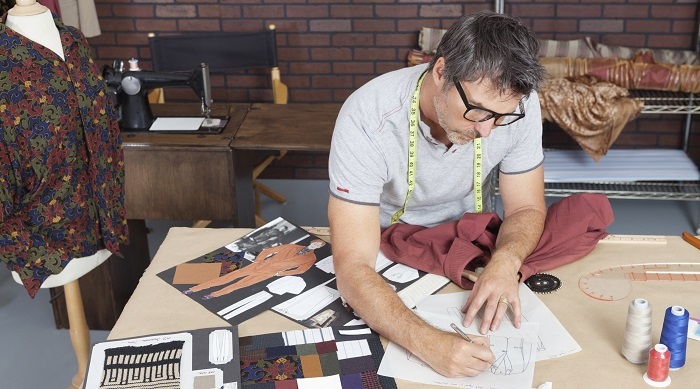

A link between elements in art and design is referred to as “rhythm,” and it fosters a sense of harmony. Patterns, interactions between colours and shapes, and repetitions of lines and forms are all examples of rhythm. Instead of allowing the eye to focus on a single focal point, rhythms help to direct the viewer’s eye around a piece. Design rhythm refers to aspects that repeat at intervals. A sound structure is produced through agreed-upon constituent placement. The dynamics can be set, and the rhythm can direct, highlight, and unite. Shape, color, tone, texture, accents, direction, and dynamic are repeated frequently. The elements are arranged, structured, and set into motion by rhythm.

Using intervals or spaces between pieces can create the illusion of rhythm or movement for the user. Five different rhythms are available to us: alternating, flowing, progressive, random, and regular rhythms. Similar to in music, rhythm aids in developing a cadence in your design, enticing users with a variety of intriguing variations. By incorporating the proper rhythm into your design, you can maximise the impact of your message.
Following are the major types of rhythm
Random rhythms are produced by repeating pieces at random intervals. While the elements could be dispersed throughout, the spacing could be a millimetre here or a centimetre there. Consider random rhythms in action in things like snow falling, beach pebbles, and traffic patterns. It’s also important to keep in mind that if you only look at a small portion of a rhythm, it might seem random. However, if you take a step back and look at a bigger section, it’s possible that the design has been given a regular but intricate rhythm. Keep in mind that you can use positive and negative images to make your design difficult to “predict” by using both the elements and the spaces between them. You’ll have virtually endless possibilities to play with if you combine more elements. René Magritte used random rhythm in an especially Intriguing way.
The regular rhythm repeats at the same intervals, much like the heart beating. Simply by drawing a grid or a sequence of vertical lines, you may quickly establish a consistent beat. An abnormal rhythm will be immediately detected by the user’s sight, which will also examine it for any other irregularities. Just keep in mind that the eye “likes” to be drawn to prominent features. Therefore, there is a chance that a design could get boring if you have a consistent rhythm in it (like the dripping of a tap).
More than one element can be repeated in a design. You make an alternate design using a 1-2-1-2-1-2 pattern. Consider the black and white chessboard squares as an example of an alternating beat in play. In actuality, an alternate beat is a regular rhythm with added complexity. It might be as simple as our chessboard, or we might picture something more complicated. There are some amazing rows of fish, birds, or other creatures that alternate rhythms. By using fish as an example, we can see that each identical fish is following another. The sequence is repeated below, but in the empty space between the rows, fish of a different color—which we assume to be the background—can be seen moving in the other direction, their delicate fin and tail lines interacting with those of the fish in the earlier pattern. Another excellent illustration of this is M.C. Escher’s Lizard (1942), which features three different colours of lizards, two of each colour facing away from the other, tail to tail. An alternating rhythm can be a simple technique to break up the monotony of a regular rhythm, no matter how basic or complex we wish to make it.
A flowing rhythm displays the elements that are repeated after bends, curves, and undulations. The waves on a beach or the sand dunes are examples of this in nature. By creating beautiful patterns of elements with a flowing rhythm, designers can emulate nature. Underwater, we can display seaweed clumps with strands gently pointing in various directions. The user envisions them rubbing up against one another.
We can create a progressive rhythm by merely altering one aspect of a motif as it is repeated. We could create a succession of circles, each larger than the one below it. Observe how the larger one at the bottom appears to be closest to you. We can modify a progressive rhythm gradually or abruptly. The smallest circle at the top could be dark, the middle one could be partially shaded, and the largest circle could only be lightly shaded. This could be accomplished by shading the smaller circles in stages. We are surrounded by evolving rhythms. You would have a progressive beat if you were to film someone dancing and then watch the movie frame by frame.
For our lives to be in harmony, rhythm is necessary. While the picture is a small part of rhythm’s potential, many people believe it to be all about the picture. It literally hypnotises people because the rhythm is so potent. Repetition of words or images has a significant impact on our mental and emotional well-being, memory, and thinking; in fact, it almost controls our brain. By pointing to texts and pictures, rhythm leads us across the page. We may quickly pick up where we left off by going to the next page. As designers, we can employ rhythm to infuse reassurance or excitement (growing over time) (a heartbeat might be perfect on a page aimed at expectant mothers, for example). Or, we might employ it to affect other feelings.